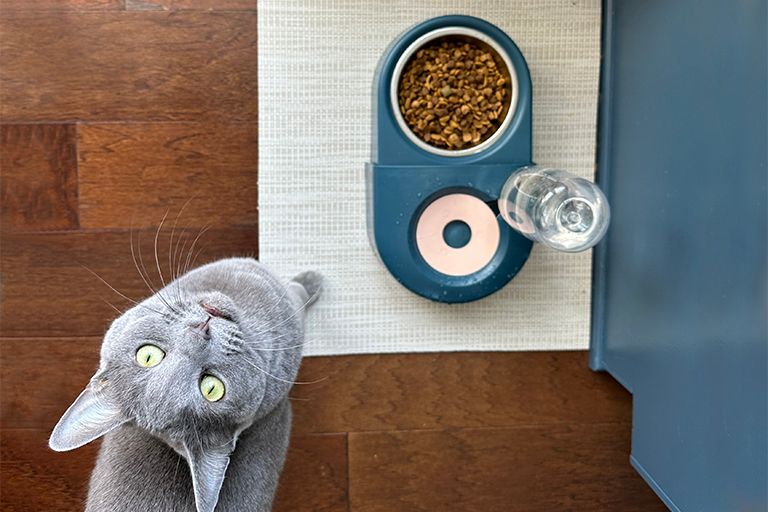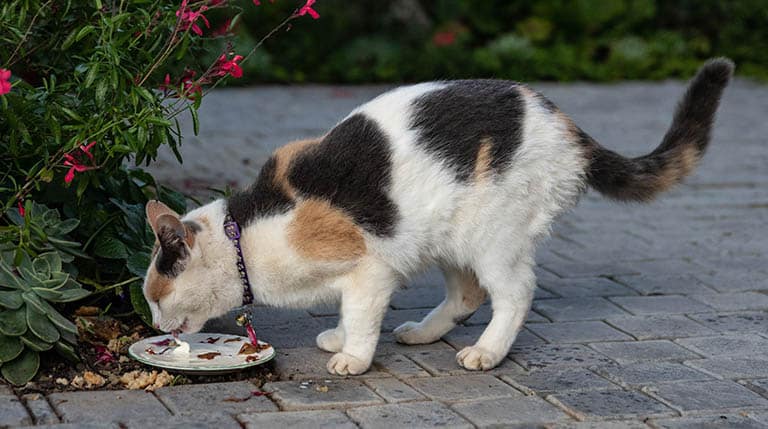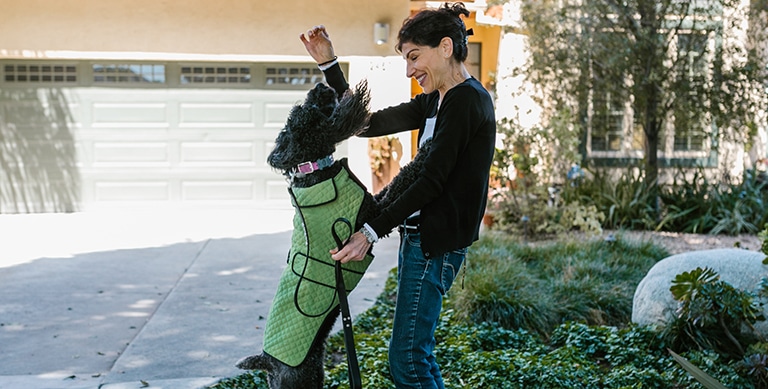A cat or dog’s pickiness, health or sensitivities are just a few of the reasons some pet parents are changing to homemade meals and treats. Learn below the benefits of homemade treats and meals for pets, tips on making the treats and food, essential tools for the kitchen and a list of popular recipes for dogs and cats.
Reasons to Make Homemade Pet Food and Treats
Reading the back of a bag of pet food or treats can be overwhelming. The ingredient list may contain more than 20 substances with many of them being fillers, chemicals and preservatives (read more on this here.) Though there are great commercial pet brands, your furry friend may need a more natural and organic diet.
Customize Treats and Food for Pet’s Needs
Pets have their own individual health issues, taste preferences and intolerances. Homemade treats and food allows the owner to customize to their pet’s specific needs. A cat or dog with food allergies does not have to be concerned with coming in contact with the substances that flare up their hypersensitivities. An animal suffering from IBD (Inflammatory Bowel Disease) does not have to worry about additional ingredients in food that may be hard on their digestive tract. In both cases, the owner has full control of what their pet consumes.
Picky eaters make it hard for their owners to find the right blend of ingredients in a commercially-made pet food. DIY treats and meals allow the pet parent to put together different types of food that may not be normally found in a bag of pet kibble. If a cat or dog is overweight, then the owner can provide their pet with the right nutrients without the additional additives.

Prevent Food Boredom
Eating the same kibble or wet food every day for every meal can be boring for the pet. They may turn their nose up at the site of their normal meal and refuse to eat. Boredom with food is particularly common for cats. Homemade meals and treats bring daily variety to the animal’s diet since something new can be cooked or mixed together at each meal. The new smells, textures and flavors get the pet excited to eat.
Healthier Ingredients
Commercial pet food has a list of ingredients that are hard to pronounce and identify. Most often these substances are preservatives, fats and chemicals. In the wild, pets’ ancestors did not eat that way. They consumed natural substances that were heavy on protein with a bit of vegetables. Treats and meals made at home contain fresher ingredients and can be organically sourced. There was no need for the unnatural additives that could have a negative impact on the pet’s health.
DIY meals and treats severely limit the amount of starches a cat or dog consumes. Starches are a common filler in commercial pet food since it is a cheap substance and allows the pet food company to cut down on costs. These fillers include white rice, white potato, soy, wheat and maize. Dogs and cats are carnivores and have little nutritional need for starches.

Tips for Making DIY Pet Food and Treats
Create A Well-Balanced Diet
Putting together a meal plan for a cat or dog takes some research. A pet’s diet needs to be well balanced. Cats and dogs need plenty of protein and some fruits and vegetables. These foods provide the animal with the right amount of healthy fats, vitamins and minerals. Speak to your vet about the right balance for your particular pet based on their sensitivities, age, energy level and the presence of any health issues. Search for credible recipes and get them vet approved. Know what foods are unsafe for cats and dogs to consume. For example, grapes and raisins are very toxic to dogs. Learn more about well-balanced diets for pets here.
Find a Reputable Source for Food
Picking the right ingredients for homemade pet food is very important. Raw meat can have parasites. Vegetables and fruits lose nutritional value as they age and become easy targets for bacteria. Find reputable sources to provide the necessary ingredients you need. Double check how fresh the food is before purchasing. Only get small amounts at a time to prevent the purchased ingredients from spoiling before you are able to cook or bake.

Cater to Pet’s Taste Buds
A human’s taste buds are very different from an animal’s taste buds. We crave salt and spices to add flavor to our food. Cats and dogs don’t need either one to find their food delicious. Some spices, such as garlic, are not good for either pet. Salt is labeled as hazardous for animals if too much is consumed. Instead of spices and salt, pay attention to the texture and the smell of the food.
Tools for the Kitchen
Making pet food and treats requires new tools for the kitchen to aid in the cooking and baking. Essential items for treats are cookie cutters. You can purchase these in fun dog- or cat-related shapes. Another item is an airtight treat jar. This allows the treats to be safe from any pet trying to sneak another snack and to keep the homemade baked goodies fresh. During the hot summer months your cat or dog may want a frozen treat. Silicone pans are perfect to fill up with different ingredients and freeze them. A jerky dehydrator dehydrates different kinds of foods including proteins and vegetables for the perfect jerky treats.
Two essential tools for the kitchen when cooking a pet’s meal are a crock-pot and a blender. Slow cookers allow you to put all the ingredients together and cook without supervision, perfect for busy pet parents. Many pet food recipes also call for a blender. This tool is great for blending together important foods that contain vitamins and minerals crucial for a pet’s balanced diet.

Popular Pet Treat and Pet Food Recipes
- Homemade Dog Food Recipe from Allrecipe.com : A great basic recipe to start with cooking for pets for the first time. Add in other foods or just leave it plain. https://www.allrecipes.com/recipe/140286/homemade-dog-food/
- Homemade Dog Food from The Almond Eater : Delicious meal that will make your pet drool. Filled with great vitamins and minerals. https://thealmondeater.com/homemade-dog-food/
- Balanced Raw Diet for Cats with IBD from Raw Feeding for Cats with IBD: Recipe plus a nutritional analysis of the recipe. https://www.rawfeedingforibdcats.org/balanced-raw-food-recipe-with-nutritional-analysis.html
- Homemade Cat Foods – 3 DIY Recipes from Floppy Cats: Goes into detail of the specifics of homemade cat food and lists three great recipes. https://www.floppycats.com/3-diy-homemade-cat-food-recipes-that-are-healthy-too.html
- Carrot and Catnip Kitty Cat Treats from Epicuricloud: Healthy carrots mixed with a sprinkle of catnip makes cats go crazy for this treat. https://www.epicuricloud.com/recipe/carrot-and-catnip-kitty-cat-treats/
- Easy Homemade Dog Treats from It Doesn’t Taste Like Chicken: Only 3 ingredients in this dog treat and super affordable. https://itdoesnttastelikechicken.com/easy-homemade-dog-treats/
- Meal Recipes and Treat Recipes from Kong: Dozens of healthy recipes for meals and treats for dogs. https://www.kongcompany.com/cuisine/
Homemade and Healthy
Different reasons to switch to homemade meals and treats for your pet include health concerns, allergies, food boredom, weight loss and digestive issues. Each of these reasons can benefit from a more natural and organic diet.
It’s best for pet owners to speak with their veterinarian and do research in order to create a well-balanced nutritional diet for their cat or dog. There are essential vitamins, minerals, proteins and fats that should be included in each meal. Finding a reputable source for food helps in this goal, and knowing which foods should not be eaten by animals keeps the pet safe.
When you decide to switch to homemade meals and treats, check out the recipes available in numerous pet cookbooks and online resources, and try out the essential tools that make cooking and baking easier. Always get vet approval for recipes before feeding your cat or dog.




































































